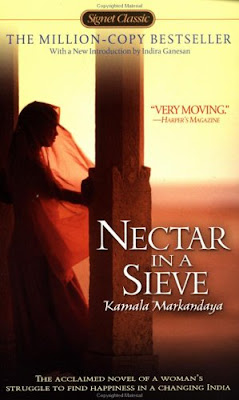 by Kamala Markandaya
by Kamala MarkandayaAt its heart, Nectar in a Sieve is a story about suffering and our response to it. The protagonist is an aging Indian woman looking back over her long life and reflecting on her fate as well as her choices. Much that happened to her, she had no say in. She was a child bride of an arranged marriage. In some respects, Providence was kind to her; in many others cruel.
But it would spoil the book to tell Rukmani’s tale before you read it. You need to experience it through her own sparse prose narrative. If you get this particular edition of the book do not read the introduction by Indira Ganesan until after you’ve finished the book. Although excellent, it contains many spoilers. Instead check out the historical context in the study guide here which will give you sufficient background to proceed well.
Like all people who live off the land, it is a journey of ups and downs, joys and woes. Very soon into the book, what becomes obvious is that it doesn’t matter so much what happens to Rukmani or her family. What counts is to endure.
Near the end of the book when an Englishman who has helped Rukmani time and again chastises her for refusing to cry out in pain, hear her thoughts:
‘Well, and what if we gave in to our troubles at every step! We would be pitiable creatures indeed to be so weak, for is not man’s spirit given to him to rise above his misfortunes? As for our wants, they are many and unfilled, for who is so rich or compassionate to supply them? Want is our companion from birth to death, familiar as the seasons of the earth, varying only in degree. What profit to bewail that which has always been and cannot change?’
Rukmani was a survivor; she knew the secret of life was to endure—patiently, quietly, lovingly.
Nectar in a Sieve is a haunting story of the sweetness of life running out as quickly as its title.
****
dedicated to my partner in reading this, Melissa

No comments:
Post a Comment